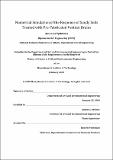Numerical simulation of the response of sandy soils treated with pre-fabricated vertical drains
Author(s)
Vytiniotis, Antonios
DownloadFull printable version (15.89Mb)
Other Contributors
Massachusetts Institute of Technology. Dept. of Civil and Environmental Engineering.
Advisor
Andrew J. Whittle.
Terms of use
Metadata
Show full item recordAbstract
This research is part of the ongoing effort of the Seismic Risk Mitigation for Port Systems Grand Challenge. It addresses the problem of numerically simulating the response of sandy soils treated with earthquake drains, for liquefaction risk mitigation. This thesis describes 1)the implementation of finite 1-D elements to simulate the uncoupled mechanical and flow properties of perforated vertical (PV) drains, 2) the investigation of scaling laws for laminar and turbulent flow inside a PV-drain, 3) the validation of the numerical models using a centrifuge experiment (SSK01) performed at UC-Davis (Kamai, et al., 2008). The mechanical and flow behavior of the drains are assumed to be uncoupled. The mechanical behavior is treated as a truss element, taking into account the axial stiffness and assuming zero bending stiffness. The flow behavior is treated using the phenomenological Darcy-Weisbach equation. The elements are implemented in the Opensees framework. Two implementations are presented, one for laminar drains, and one for fully turbulent drains. Both of these implementations are used to estimate also the effect of drain storage capacity. It has been illustrated that the flow in the drains in model scale and in prototype scale might be qualitatively different. If the centrifuge model is scaled N times Reynolds number (Re) is N times larger in prototype scale, so under common situations model scale flow can be laminar even if at the prototype scale flow is fully turbulent. A methodology is presented to elect properties of model scale drains (where flow is laminar) to represent prototype drains (where flow is turbulent). Validation has been performed against SSK01 centrifuge test. Results show good agreement with experimental data. (cont.) Limitations of the constitutive soil model and the selected input parameters are discussed. Model scale results validate the consideration of the storage capacity effect, and thus use of the implemented drain elements. On the other hand the need for turbulent flow (rather than laminar) drains does not affect significantly the results of the specific test used.
Description
Thesis (S.M.)--Massachusetts Institute of Technology, Dept. of Civil and Environmental Engineering, 2009. This electronic version was submitted by the student author. The certified thesis is available in the Institute Archives and Special Collections. Includes bibliographical references (p. 118-121).
Date issued
2009Department
Massachusetts Institute of Technology. Department of Civil and Environmental EngineeringPublisher
Massachusetts Institute of Technology
Keywords
Civil and Environmental Engineering.